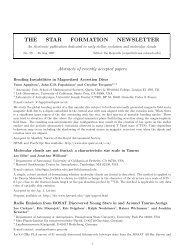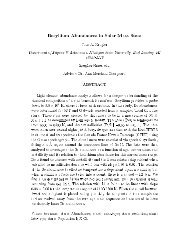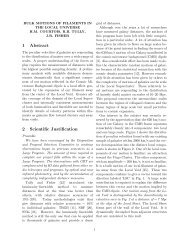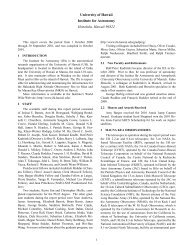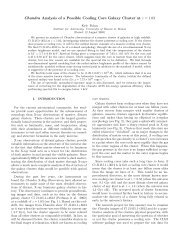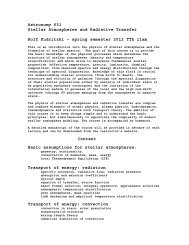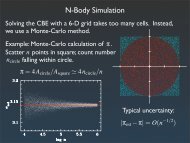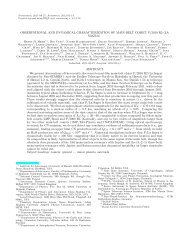Young Stellar Clusters and Star Formation Throughout the Galaxy
Young Stellar Clusters and Star Formation Throughout the Galaxy
Young Stellar Clusters and Star Formation Throughout the Galaxy
Create successful ePaper yourself
Turn your PDF publications into a flip-book with our unique Google optimized e-Paper software.
<strong>Young</strong> <strong>Stellar</strong> <strong>Clusters</strong> <strong>and</strong> <strong>Star</strong> <strong>Formation</strong><br />
<strong>Throughout</strong> <strong>the</strong> <strong>Galaxy</strong><br />
A Science Working Paper for <strong>the</strong> Astro2010 Survey<br />
Planetary Systems <strong>and</strong> <strong>Star</strong> <strong>Formation</strong> <strong>and</strong><br />
The Galactic Neighborhood Science Panels<br />
Eric Feigelson* 1 , Fred Adams 2 , Lori Allen 3 , Edwin Bergin 2 , John Bally 4 , Zoltan Balog 5 ,<br />
Tyler Bourke 6 , Crystal Brogan 7 , You-Hua Chu 8 , Edward Churchwell 9 , Marc Gagne 10 ,<br />
Konstantin Getman 1 , Todd Hunter 7 , Larry Morgan 7 , Philip Massey 11 ,<br />
Mordecai-Mark Mac Low 12 , Eric Mamajek 13 , S. Thomas Megeath 14 , C. Robert O’Dell 15 ,<br />
Jill Rathborne 6 , Luisa Rebull 16 , Steven Stahler 17 , Leisa Townsley 1 , Junfeng Wang 6 ,<br />
Jonathan Williams 18<br />
1 Penn State University 2 University of Michigan<br />
3 National Optical Astronomy Observatory<br />
4 University of Colorado 5 University of Arizona 6 Harvard-Smithsonian Center for Astrophysics<br />
7 National Radio Astronomy Observatory 8 University of Illinois 9 University of Wisconsin<br />
10 West Chester University 11 Lowell Observatory 12 American Museum of Natural History<br />
13<br />
University of Rochester 14 University of Toledo 15 V<strong>and</strong>erbilt University<br />
16 17<br />
Spitzer Science Center University of California Berkeley 18 University of Hawaii<br />
* Contact person: Eric Feigelson, Department of Astronomy & Astrophysics, Penn State<br />
University. Email: edf@astro.psu.edu 814-865-0162<br />
1
Introduction<br />
Most stars are born in rich young stellar clusters (YSCs) embedded in giant molecular clouds<br />
(Lada & Lada 2003). They represent <strong>the</strong> dominant mode of star formation after <strong>the</strong> primordial<br />
era. The most massive stars live out <strong>the</strong>ir short lives <strong>the</strong>re, profoundly influencing <strong>the</strong>ir natal<br />
environments by ionizing HII regions, inflating wind-blown bubbles <strong>and</strong> champagne flows, <strong>and</strong><br />
soon exploding as supernovae (Beu<strong>the</strong>r et al. 2008). Their ejecta chemically enrich <strong>the</strong><br />
interstellar medium (ISM), drive turbulence, power <strong>the</strong> <strong>Galaxy</strong>’s cosmic ray flux, trigger<br />
secondary cluster formation, <strong>and</strong> carve superbubbles extending into <strong>the</strong> Galactic halo (Cesaroni<br />
et al. 2005). On large scales, associations of massive stars produce supernovae that power superbubbles<br />
which propel <strong>the</strong> energetics of <strong>the</strong> disk <strong>and</strong> halo interstellar medium. Converging flows<br />
where superbubbles intersect promote molecular cloud formation <strong>and</strong> <strong>the</strong> next generation of star<br />
formation. In starburst environments, super-star clusters drive nuclear super-winds that heat,<br />
ionize <strong>and</strong> chemically enrich <strong>the</strong> intergalactic medium.<br />
On smaller scales, <strong>the</strong> exp<strong>and</strong>ing HII regions <strong>and</strong> supernova remnants from massive stars<br />
paradoxically trigger new star formation as <strong>the</strong>y destroy <strong>the</strong>ir natal clouds (Elmegreen & Palous<br />
2007). Thous<strong>and</strong>s of lower-mass pre-main sequence stars accompany <strong>the</strong> massive stars in each<br />
YSC, both in <strong>the</strong> dense clusters around OB stars <strong>and</strong> in <strong>the</strong> surrounding molecular cloud. Planet<br />
formation may be qualitatively different in YSC environments compared to isolated star<br />
formation environments, but it is not clear whe<strong>the</strong>r planet growth is inhibited or promoted in <strong>the</strong><br />
vicinity of OB stars (Hollenbach et al. 2000; Thorpe & Bally 2004). There is evidence -- based<br />
on <strong>the</strong> truncated Kuiper Belt, H-poor Uranus <strong>and</strong> Neptune, <strong>and</strong> short-lived radionuclides -- that<br />
our Solar System formed in such a rich cluster (Hester et al. 2004).<br />
While this schematic picture of YSCs is established, our underst<strong>and</strong>ing of <strong>the</strong> astrophysical<br />
processes at work is still quite primitive. Do clusters form rapidly during a single collapse event<br />
or slowly over many crossing times (Elmegreen 2000; Tan et al. 2006)? Why are massive stars<br />
rare, <strong>and</strong> do <strong>the</strong>y via accretion disks or stellar mergers (Zinnecker & Yorke 2007)? How does<br />
<strong>the</strong> feedback from OB stars both halt <strong>and</strong> promote fur<strong>the</strong>r star formation? Is <strong>the</strong> stellar Initial<br />
Mass Function (IMF) truly universal over a wide range of cloud conditions, <strong>and</strong> what produces<br />
its distinctive shape (Bonnell et al. 2007)? When <strong>and</strong> why does primordial mass segregation (i.e.<br />
concentration of <strong>the</strong> OB stars into <strong>the</strong> core) occur (Huff & Stahler 2007)? What effect do<br />
shocked OB winds have on <strong>the</strong> physics of <strong>the</strong> HII region <strong>and</strong> <strong>the</strong> confining molecular cloud<br />
(Townsley et al. 2003)? What fraction of stars in <strong>the</strong> <strong>Galaxy</strong> form from triggered processes?<br />
What determines whe<strong>the</strong>r a young stellar cluster survives <strong>the</strong> dispersal of its parental molecular<br />
gas <strong>and</strong> becomes a bound open or globular cluster? How does <strong>the</strong> cluster environment influence<br />
<strong>the</strong> evolution of protoplanetary disks <strong>and</strong> subsequent formation of planetary systems?<br />
While considerable progress was made in underst<strong>and</strong>ing <strong>the</strong> formation of isolated stars during<br />
<strong>the</strong> past two decades, <strong>the</strong> more complex phenomena involved in clustered star formation have<br />
only just begun to be elucidated. Powerful new datasets are now emerging from both spacebased<br />
(Spitzer <strong>and</strong> Ch<strong>and</strong>ra) <strong>and</strong> ground-based (sub-millimeter mapping, wide-field infrared<br />
imaging <strong>and</strong> multi-object spectroscopy) surveys. The technologies are challenging: YSC<br />
observational studies require both high spatial resolution <strong>and</strong> wide fields at wavelengths that<br />
penetrate obscuring molecular material <strong>and</strong> remove contaminating Galactic field stars. New<br />
surveys are reaching beyond <strong>the</strong> closest clusters in Orion to study massive star forming regions<br />
2
along <strong>the</strong> <strong>Galaxy</strong>’s nearby spiral arms <strong>and</strong> in Local Group galaxies, providing critical links to<br />
extragalactic HII regions <strong>and</strong> starburst galaxies. The proliferation of <strong>the</strong>ories concerning, for<br />
example, OB star formation <strong>and</strong> <strong>the</strong> establishment of <strong>the</strong> IMF, can soon be tested.<br />
The 2010-19 decade promises to witness breakthroughs in our underst<strong>and</strong>ing of star formation at<br />
this crucial intermediate scale between individual stars <strong>and</strong> entire galaxies. Studying young<br />
clusters, particularly those embedded in <strong>the</strong>ir natal clouds, requires multi-wavelength<br />
observations ranging from hard X-rays to radio waves. <strong>Young</strong> clusters are laboratories<br />
where <strong>the</strong> birth of stars <strong>and</strong> planets can be studied with large statistical samples, feedback<br />
mechanisms can be investigated, <strong>and</strong> foundations of cosmic starburst phenomena can be<br />
decoded. We outline here eight scientific issues ready for major advances in <strong>the</strong> coming decade.<br />
The IMFs <strong>and</strong> structures of rich stellar clusters<br />
The IMF in local YSCs <strong>and</strong> in older stellar populations appears to be a Salpeter powerlaw<br />
distribution at masses above ~1 M O appended to lognormal distribution peaking around 0.3 M O<br />
(Chabrier 2003). However, some of <strong>the</strong> most massive clusters in <strong>the</strong> Local Group appear to have<br />
a top-heavy IMF (Harayama et al. 2008). Underst<strong>and</strong>ing <strong>the</strong> conditions of OB star formation<br />
<strong>and</strong> <strong>the</strong> physical origin of <strong>the</strong> IMF impacts our underst<strong>and</strong>ing of starburst galaxies, <strong>the</strong> first stars,<br />
<strong>and</strong> <strong>the</strong> Epoch of Reionization. Critical clues will emerge from infrared <strong>and</strong> X-ray surveys that<br />
sample <strong>the</strong> lower mass populations (Figures 1-4); morphological studies can <strong>the</strong>n examine<br />
smooth vs. clumpy structures <strong>and</strong> <strong>the</strong> presence of mass segregation. Kinematical investigations<br />
using precision astrometry <strong>and</strong> radial velocities will complement morphological studies to<br />
challenge <strong>the</strong>oretical models of turbulent cloud collapse <strong>and</strong> early cluster evolution.<br />
Triggered star formation around young stellar clusters<br />
In <strong>the</strong> past, it had been speculated that <strong>the</strong> impact of supernova shocks on molecular clouds were<br />
a major trigger of secondary star formation. While this now looks unlikely (Joung & Mac Low<br />
2006), recent research has instead pointed to <strong>the</strong> importance of ionization <strong>and</strong> wind shocks from<br />
pre-supernova OB stars. Triggered populations are found both within small bright-rimmed<br />
clouds <strong>and</strong> larger cloud structures on <strong>the</strong> edges of exp<strong>and</strong>ing HII regions using infrared <strong>and</strong> X-<br />
ray images (Figure 3). The evidence supports <strong>the</strong>oretical `collect-<strong>and</strong>-collapse’ models on large<br />
scales (Elmegreen & Lada 1977) <strong>and</strong> `radiative driven implosion’ on small scales (Bertoldi<br />
1989). None<strong>the</strong>less, <strong>the</strong> quantitative importance of triggering in Galactic star formation has not<br />
been established <strong>and</strong> remains a future challenge.<br />
The fate of OB winds<br />
The inner regions of radiatively accelerated OB winds can be studied with ultraviolet P Cygni<br />
absorption lines <strong>and</strong> X-ray emission lines. But in <strong>the</strong>ir outer regions, <strong>the</strong> winds can only be<br />
observed indirectly. However, with sensitive high-resolution X-ray images, <strong>the</strong> faint emission<br />
from shocked OB winds can be seen on parsec scales (Townsley et al. 2003). The hot gas<br />
flowing from central cluster in M 17 (Figure 1) is a prime example of <strong>the</strong>se X-ray flows <strong>and</strong><br />
reveals <strong>the</strong> winds’ confinement by <strong>and</strong> escape from <strong>the</strong> molecular cloud environment. The<br />
astrophysics of HII regions must be reconsidered to account for interiors filled with 10 7 K ra<strong>the</strong>r<br />
than 10 4 K plasma.<br />
3
The stellar populations of Infrared Dark Clouds (IRDCs)<br />
Studies of <strong>the</strong> Galactic Plane at mid-infrared wavelengths during <strong>the</strong> 1990s first identified<br />
IRDCs as dark extinction features seen in absorption against <strong>the</strong> bright mid-IR emission arising<br />
from <strong>the</strong> Galactic (Carey et al. 1998; see Figure 2). IRDCs are ubiquitous across <strong>the</strong> <strong>Galaxy</strong><br />
with filamentary morphologies, very high densities (n H2 >10 5 cm -3 , N H ~ 10 23 -10 25 cm -2 ), <strong>and</strong> low<br />
temperatures (T10 4 –<br />
10 5 M O ) are identified, such as NGC 3603 <strong>and</strong> <strong>the</strong> Arches Cluster. These clusters harbor <strong>the</strong><br />
most massive (M~100 M O ) main sequence, supergiant <strong>and</strong> Wolf-Rayet stars with prodigious<br />
winds <strong>and</strong> supernova remnants that have <strong>the</strong> greatest influence on <strong>the</strong> galactic interstellar<br />
medium. Radio <strong>and</strong> millimeter studies pierce <strong>the</strong> material surrounding <strong>the</strong> earliest stages of<br />
massive star formation. Deep, high-spatial resolution mid-infrared <strong>and</strong> X-ray studies are needed<br />
to locate <strong>and</strong> characterize <strong>the</strong> spatial, mass <strong>and</strong> age distributions of stars in <strong>the</strong>se clusters. Their<br />
relationship to local interstellar environments is also critical to test <strong>the</strong>ories of <strong>the</strong>ir origins; e.g.<br />
whe<strong>the</strong>r top-heavy IMFs preferentially form where <strong>the</strong> interstellar pressure is unusually high<br />
(McKee & Tan 2002).<br />
Tracing star formation throughout <strong>the</strong> Galactic Disk<br />
Wide-field surveys at penetrating wavelengths have revealed a remarkable medley of interstellar<br />
structures that trace star cluster formation across <strong>the</strong> Galactic Plane. The first indication was 21-<br />
cm line studies of exp<strong>and</strong>ing supershells <strong>and</strong> worms in <strong>the</strong> plane (Heiles 1979), leading to a<br />
model of a thous<strong>and</strong> chimneys exhausting wind <strong>and</strong> supernova ejecta into <strong>the</strong> Galactic halo<br />
(Norman & Ikeuchi 1989). More recently, <strong>the</strong> GLIMPSE mid-infrared survey with <strong>the</strong> Spitzer<br />
Space Telescope <strong>and</strong> <strong>the</strong> MAGPIS centimeter-wavelength survey with <strong>the</strong> Very Large Array<br />
reveal hundreds of previously unknown wind-swept, ionized bubbles <strong>and</strong> supernova remnants<br />
(Figure 5). Each of <strong>the</strong>se are likely produced by yet-unknown young stellar clusters. Most star<br />
formation occurs in <strong>the</strong> inner 5 kpc of <strong>the</strong> <strong>Galaxy</strong>, <strong>and</strong> many star formation regions lie on <strong>the</strong><br />
uncharted far side of <strong>the</strong> Galactic disk.<br />
The Galactic Center region<br />
Were it viewed from afar, <strong>the</strong> Milky Way would be seen as a mild nuclear starburst galaxy.<br />
Many of <strong>the</strong> most massive star, massive stars, <strong>and</strong> giant molecular clouds reside in <strong>the</strong> inner 1–<br />
100 pc. The molecular clouds have internal turbulent motions 5 times greater than seen in<br />
nearby clouds (Miyazaki & Tsuboi 2000). The intercloud medium in this region is<br />
extraordinarily hot <strong>and</strong> dense from thous<strong>and</strong>s of past supernova explosions with a pressure ~10 3<br />
times that of <strong>the</strong> medium near <strong>the</strong> Sun (Muno et al. 2004). Though difficult to discern, a<br />
4
supernova-driven wind appears to be emerging perpendicular to <strong>the</strong> disk (Law et al. 2009).<br />
Most of <strong>the</strong> massive star formation in <strong>the</strong> region has yet to be identified due to <strong>the</strong> observational<br />
difficulties of heavy obscuration <strong>and</strong> crowding (Figure 6).<br />
<strong>Star</strong> clusters in <strong>the</strong> Magellanic Clouds<br />
Massive star clusters in <strong>the</strong> Large <strong>and</strong> Small Magellanic Clouds (MCs) are more accessible than<br />
distant Galactic clusters due to low intervening obscuration, but are ~10 times more distant. The<br />
high-mass star formation rate in <strong>the</strong> MCs are an order of magnitude higher than in <strong>the</strong> Milky<br />
Way <strong>Galaxy</strong>, <strong>and</strong> thus serve as an invaluable bridge to underst<strong>and</strong>ing cosmic starburst<br />
phenomena (Figure 7). Studies of <strong>the</strong> most extreme super-star clusters will illuminate <strong>the</strong> birth of<br />
globular clusters <strong>and</strong> low-metallicity star formation in <strong>the</strong> early Universe. With current<br />
technology, global properties of major clusters are well-established, individual OB/WR stars can<br />
be studied, <strong>and</strong> <strong>the</strong> more luminous low-mass pre-main sequence objects can be detected. 30 Dor<br />
<strong>and</strong> o<strong>the</strong>r active complex give a uniquely detailed view of <strong>the</strong> effects of multiple supernova<br />
explosions. The high sensitivity <strong>and</strong> sub-arcsecond resolution of JWST <strong>and</strong> 8m-class telescopes<br />
are essential to make major steps forward in MC research.<br />
Programmatic recommendations<br />
YSC studies are central to our underst<strong>and</strong>ing of star <strong>and</strong> planet formation across <strong>the</strong> <strong>Galaxy</strong> <strong>and</strong><br />
throughout cosmic history. The astrophysics of star formation <strong>and</strong> pre-main sequence evolution<br />
has proved to be far more complex than early concepts that involved only gravitational collapse<br />
<strong>and</strong> convective stellar interiors. While individual protoplanetary disks <strong>and</strong> exoplanetary systems<br />
are best studied close to <strong>the</strong> Sun, most stars likely experience hostile YSC environments with OB<br />
radiation <strong>and</strong> SN ejecta during a portion of <strong>the</strong> planet formation epoch. <strong>Star</strong>burst investigations,<br />
whe<strong>the</strong>r in nearby galaxies or at high redshifts, require underst<strong>and</strong>ing of local YSCs to derive<br />
astrophysical meaning from correlations between global quantities observable from great<br />
distances.<br />
YSC studies are poised to make major progress during <strong>the</strong> 2010-20 decade, but will require a<br />
wide range of scientific capabilities. Some of <strong>the</strong>se are already underway including JWST,<br />
EVLA, VLBA, ALMA, Herschel, SOFIA <strong>and</strong> Ch<strong>and</strong>ra. Here we outline five urgent needs<br />
which need policy support:<br />
Development of a ground-based 30m-class adaptive-optics infrared telescope Perhaps <strong>the</strong><br />
most critical instrument needed to propel our underst<strong>and</strong>ing of star formation in our <strong>Galaxy</strong> is a<br />
30m-class telescope such as <strong>the</strong> GMT, TMT <strong>and</strong> EELT. Galactic Plane fields are extremely<br />
crowded <strong>and</strong> <strong>the</strong>
spatial resolution imaging with JWST <strong>and</strong> ALMA, <strong>the</strong> Ch<strong>and</strong>ra X-ray Observatory should<br />
continue operations through <strong>the</strong> decade support <strong>the</strong>se new projects. to extend existing photonstarved<br />
YSC studies, <strong>and</strong> to extend X-ray imaging to more distant <strong>and</strong> obscured YSCs. Strong<br />
support is needed for <strong>the</strong> International X-ray Observatory, <strong>and</strong> technology development for <strong>the</strong><br />
Generation-X mission should proceed energetically; its planned 0.1” resolution <strong>and</strong> 500x-<br />
Ch<strong>and</strong>ra sensitivity is superbly suited to YSC studies. The proposed Wide Field X-ray<br />
Telescope will give a unique scan of stellar clusters in <strong>the</strong> Galactic Plane.<br />
Large-aperture sub-millimeter <strong>and</strong> far-infrared telescopes Characterizing <strong>the</strong> molecular<br />
cloud precursors of YSCs requires submillimeter line <strong>and</strong> continuum mapping high resolution<br />
<strong>and</strong> wide-area coverage. These include a large filled-aperture telescope such as <strong>the</strong> 30m CCAT<br />
planned for Chile, <strong>the</strong> LMT in Mexico, <strong>and</strong> focal-plane array upgrades to ALMA <strong>and</strong> <strong>the</strong> GBT.<br />
A space-based far-IR telescope would extend capabilities into <strong>the</strong> critical 50-150 µm range.<br />
Development of multi-object infrared spectrographs Although imaging <strong>and</strong> broad-b<strong>and</strong><br />
photometry are essential first steps in discovering YSCs clusters throughout <strong>the</strong> Galactic disk,<br />
spectroscopy of individual stars (including low mass members) is needed to measure individual<br />
masses, ages, accretion, <strong>and</strong> metallicity, <strong>and</strong> radial velocities (e.g. Furesz et al. 2008). Multiobject<br />
spectroscopy must move into <strong>the</strong> infrared b<strong>and</strong>: FLAMINGOS-2/Gemini <strong>and</strong><br />
MOIRCS/Subaru are already underway, <strong>and</strong> plans are being developed for IRMOS/TMT.<br />
Support for <strong>the</strong>oretical modeling Major commitments of time on high-performance computers<br />
are needed to extend <strong>the</strong>oretical simulations of YSC formation to realistically massive clusters<br />
(Bate et al. 2009). Simulations of YSC formation are beginning to incorporate <strong>the</strong> complex<br />
astrophysics of turbulent, partly-ionized magnetized molecular clouds, line <strong>and</strong> continuum<br />
radiative transfer, N-body gravitational interactions, <strong>and</strong> OB star radiation pressure, ionization<br />
<strong>and</strong> wind feedback. More analytical <strong>the</strong>ory is also critically needed. Funding for individual<br />
investigator programs, supporting both <strong>the</strong>ory <strong>and</strong> observational work at ground-based<br />
telescopes, should be streng<strong>the</strong>ned.<br />
Alves & Homeier 2003, ApJ 589, L45 Helf<strong>and</strong>, Becker et al. 2006, AJ 131, 2525<br />
Bate et al. 2003, MNRAS 392, 590 Hester et al. 2004, Science 304, 111<br />
Bertoldi 1989, ApJ 346, 735 Hollenbach et al. 2000, in PIV, 401<br />
Beu<strong>the</strong>r et al. (eds) 2008, Massive <strong>Star</strong> <strong>Formation</strong> Huff & Stahler 2007, ApJ 666, 281<br />
Bonnell et al. 2007, in Protostars & Planets V, 149 Joung & Mac Low 2006, ApJ 653, 1266<br />
Briceno et al. 2007, in Protostars & Planets V, 345 Koenig, Allen et al. 2008, ApJ 688, 1142<br />
Carey et al. 1998, ApJ 508, 721 Lada & Lada 2003, ARAA 41, 57<br />
Cesaroni et al. 2007, in Protostars & Planets V, 197 Law, Backer et al. 2009, arXiv:0901.1480<br />
Chabrier 2003, PASP 115, 763 McKee & Tan 2002, Nature 416, 59<br />
Churchwell et al. 2006, ApJ 649, 759 Miyazaki & Tsuboi 2000, ApJ 536, 357<br />
Deharveng, Lefloch et al. 2006, A&A 458, 191 Muno, Baganoff et al. 2004, ApJ 613, 326<br />
Elmegreen & Lada 1977, ApJ 214, 725 Norman & Ikeuchi 1989, ApJ 345, 372<br />
Elmegreen 2000, ApJ 530, 277<br />
Rathborne, Jackson et al. 2005, ApJ 630, L181<br />
Elmegreen & Palous (eds) 2007, IAU Symp 237 Rathborne, Jackson et al. 2006, ApJ 641, 389<br />
Feigelson et al. 2007, in Protostars & Planets V, 313 Tan, Krumholz & McKee 2006, ApJ 641, L121<br />
Figer 2008, in IAU Symp 250, 247<br />
Throop & Bally 2005, ApJ 623, L149<br />
Furesz, Hartmann et al. 2008, ApJ 676, 1109 Townsley, Feigelson et al. 2003, ApJ 593, 874<br />
Harayama et al. 2008, ApJ 675, 1319 Zinnecker & Yorke 2007, ARA&A 45, 481<br />
Heiles 1979, ApJ 229 533<br />
6
Fig. 1 Nearby rich cluster M 17 at<br />
d=1.6 kpc. This image subtending<br />
15x10 pc shows a Ch<strong>and</strong>ra ACIS image<br />
with ~2500 young stars in <strong>the</strong> central<br />
NGC 6618 cluster <strong>and</strong> small triggered<br />
clusters in <strong>the</strong> surrounding cloud. The<br />
shocked O star winds (blue structure)<br />
flow into <strong>the</strong> Galactic ISM, channeled<br />
by cold molecular gas shown by PAHemitting<br />
dust (red structure) (Townsley<br />
et al., in preparation).<br />
Figure 2 IRDC G34.4+023 at d~3.7 kpc<br />
with molecular mass M~7500 M O (Rathborne<br />
et al. 2005). IRAM 1.2mm continuum<br />
contours overlaid on Spitzer IRAC (left) <strong>and</strong><br />
MIPS (right) images.<br />
Figure 3 Triggered star formation on <strong>the</strong> edge of an<br />
HII region This composite optical (blue) <strong>and</strong> nearinfrared<br />
(yellow) image of Sharpless 219 shows a<br />
embedded cluster triggered by an exp<strong>and</strong>ing HII region<br />
(Deharveng et al. 2006).<br />
Figure 4 <strong>Young</strong> stars <strong>and</strong> bubbles in W 5 at<br />
d=2 kpc. Infrared excess stars (Class I=red, Class<br />
II=green, Class II/III= yellow) embedded in<br />
molecular cloud material surrounding large bubbles<br />
produced by OB stars revealed by a MIPS image<br />
(Koenig et al. 2008).<br />
7
Figure 5 The bubbling Galactic Disk Left: Four examples of <strong>the</strong> hundreds of interstellar bubbles found<br />
in <strong>the</strong> Spitzer GLIMPSE survey (Churchwell et al. 2006). Over 85% of <strong>the</strong>m do not have known star<br />
clusters. Right: A complex field from <strong>the</strong> cm-b<strong>and</strong> continuumVLA Multi-Array Galactic Plane Imaging<br />
Survey (MAGPIS) with both HII regions <strong>and</strong> supernova remnants (Helf<strong>and</strong> et al. 2006).<br />
Figure 6 The challenge of distant cluster studies A study of a 5’x5’ region in <strong>the</strong> unusually massive<br />
W49A star forming region at d~11 pc with <strong>the</strong> SofI instrument on <strong>the</strong> ESO-NTT (Alves & Homeier<br />
2003). The clusters suffer A V ~20-50 mag absorption <strong>and</strong> overwhelming contamination by field stars;<br />
only O stars with M>20 M O can be identified.<br />
Figure 7 30 Dor, <strong>the</strong> starburst in <strong>the</strong> Local Group<br />
at d=55 kpc. This image spans 200 pc <strong>and</strong> shows <strong>the</strong><br />
hot supernova bubbles (Ch<strong>and</strong>ra 0.5-2 keV b<strong>and</strong>, red)<br />
inside shells of HII (MCELS Hα, green) <strong>and</strong> heated<br />
dust (Spitzer 8µm, blue). Courtesy L. Townsley, Y.-<br />
H. Chu & B. Br<strong>and</strong>l.<br />
8



